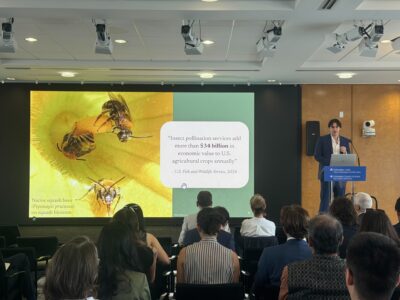
As part of their Urban Ecology course, students in the MPA-ESP program take part in a series of field trips, applying classroom learning to real-world issues. From hiking to the top of a landfill reclamation site, to paddling the murky waters of the Bronx River, students were immersed in the challenges and complexities associated with urban restoration projects.
The students spent two Fridays in July exploring New York City. Their first stop was at the Fountain Avenue landfill in Brooklyn. Once a major dumpsite for New York City, the site is now a verdant 400-acre nature preserve. Students learned of the different restoration strategies and issues contemplated by decision makers, from choosing which plants to were best suited to the environment, to pest management and community engagement. Ultimately the site will be transformed into a place where community members will gather for outdoor plays, concerts and nature walks, bridging environmental restoration with community development.
Similarly, visits to Pelham Bay Park and Randall’s Island exposed students to restoration projects addressing urban forests and wetlands. Under a forest canopy, students learned of New York’s One Million Trees campaign, and how urban parks have many co-benefits. Both Randall’s Island and Pelham Bay Park are employing initiatives to restore urban wetlands, which provide seminal habitats, but also ecosystem services like water quality improvement and storm surge protection.

Last on their string of field trips was a visit to the Bronx-based organization, Rocking the Boat. Rocking the Boat trains youth from the South Bronx to build rowboats, which are then used to collect water samples and other ecological data from the Bronx river. Students can receive academic credit for the work at the organization, and are matched with social workers to provide emotional and academic support.
Shannon Doherty, a current ESP student says, “I appreciate the diversity of the field trips because it’s useful to see how environmental policy can be applied in a broad spectrum of workplaces and jobs. Our trip to the non-profit organization, Rocking the Boat, was especially inspiring for me. I had never really considered doing non-profit work, but now to see how directly it can bridge together environmental progress and social justice, I am much more interested in seeking out opportunities in that sector”.
The field trips are an invaluable component of the ESP program, showcasing the novel and exciting ways students may use their degree. Indeed, Anvita Akkur, also a current student says, “They were a great way to get out of the classroom and see real-life applications of concepts we are currently learning. It was also inspiring to see professionals in our field making impacts on the communities in which we live”.
****
Students in the MPA in Environmental Science and Policy program enroll in a year-long, 54-credit program offered at Columbia University’s School of International and Public Affairs, in partnership with the Earth Institute.
Since it began in 2002, the MPA in Environmental Science and Policy program has given students the hands-on experience, and the analytical and decision-making tools to implement effective environmental and sustainable management policies. The program’s 741 graduates have advanced to jobs in domestic and international environmental policy, working in government, private and non-profit sectors. Their work involves issues of sustainability, resource use and global change, in fields focused on air, water, climate, energy efficiency, food, agriculture, transportation and waste management. They work as consultants, advisers, project managers, program directors, policy analysts, teachers, researchers and environmental scientists and engineers.
Visit our website for more information: http://mpaenvironment.ei.columbia.edu/



